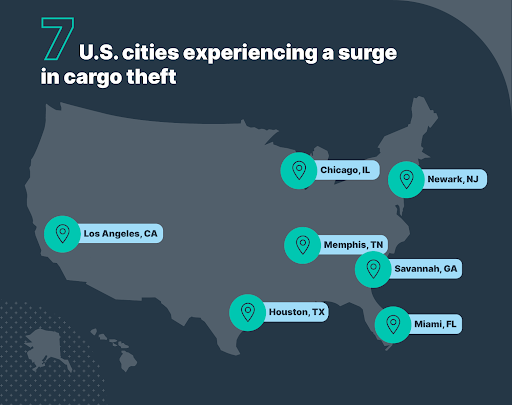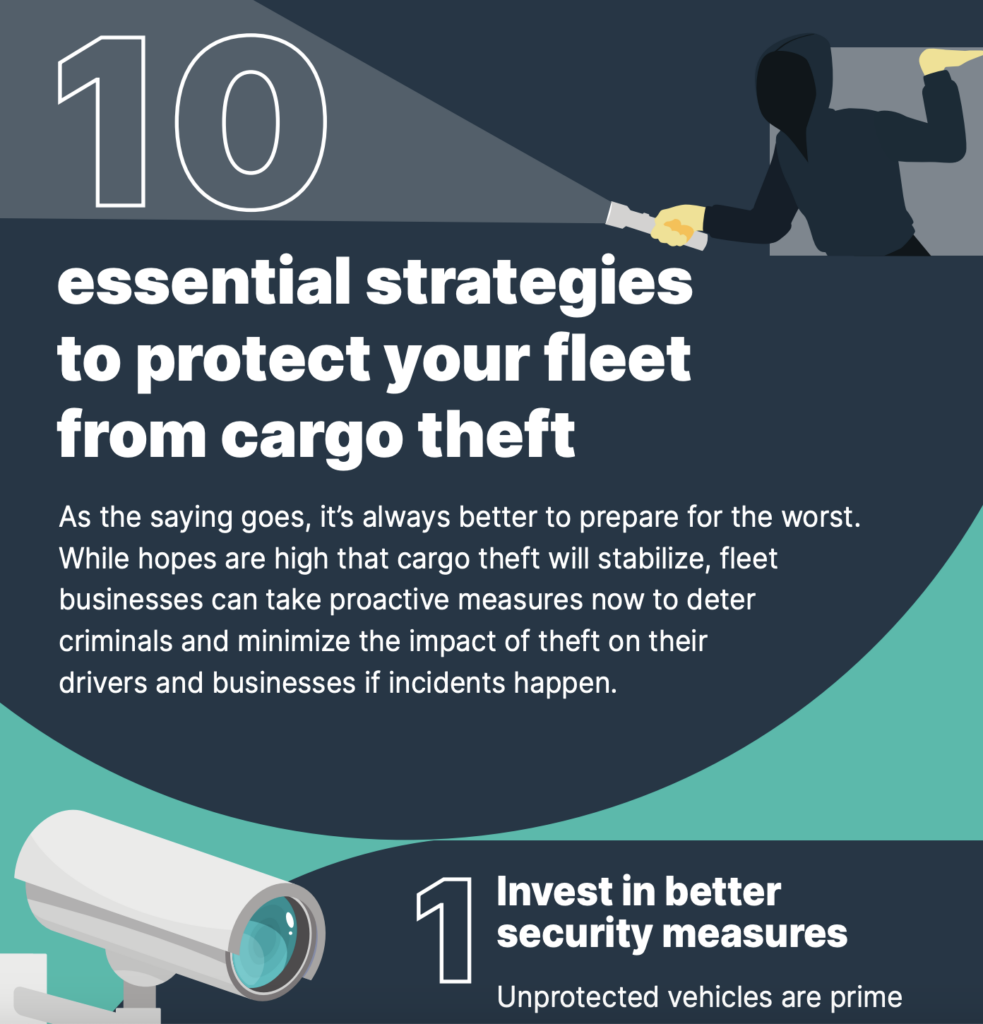Stay connected
Subscribe to our Inside WEX blog and follow us on social media for the insider view on everything WEX, from payments innovation to what it means to be a WEXer.

The trucking industry has faced its fair share of challenges in recent years—from fluctuating fuel prices to lingering supply chain disruptions and more. But one persistent issue remains: cargo theft.
Here, we’ll discuss just how disruptive cargo theft is, both to individual trucking businesses and the industry as a whole, and how fleet managers can take proactive steps to help mitigate business impacts.

In Q4 2024, the freight security network, CargoNet, reported a significant year-over-year increase in theft incidents. Q3 2024 saw a record 776 cargo theft events across the U.S. and Canada. This represents a 14% increase as compared to the prior year’s third quarter. The total value of stolen goods was well over $39 million in Q3 2024.
While cargo thieves tend to target larger freight and vehicles, fleets of all sizes are still vulnerable to theft. Warehouses, distribution centers, and truck stops are also top-targeted locations.
So, whether you operate a delivery service, transportation company, or any business reliant on transporting goods, protecting your assets against theft should be a priority.

Share 10 essential strategies to prevent cargo theft with your drivers today.
Before exploring a few theft prevention strategies, it’s important to know what you’re up against. Unfortunately, savvy criminals have devised numerous ways to gain access to valuable cargo. Before we can plan to protect ourselves against a cargo theft incident, we have to know how they commonly happen.
Fittingly, straight cargo theft is perhaps the most straightforward method. It happens when someone steals an entire shipment of cargo from a location where it’s stored, like warehouse loading docks, airports, or train stops.
More sophisticated than other methods, strategic cargo theft is a planned theft of goods during their transportation or storage. Criminals often employ deceptive social engineering strategies or fraud and use inside knowledge of the supply chain to their advantage.
Whether taken by force or simply stolen while the truck driver steps inside a rest stop, burglaries and hijackings are a common method of cargo theft. They can be spontaneous or planned, wherein a criminal may spend hours or days tracking a vehicle’s route to plan the perfect attack.
Unfortunately, there is a small subset of drivers who don’t have ethical intentions. When drivers get involved in cargo theft, it could mean they simply hand cargo over to thieves willingly for money or even stage a hijacking to cover their tracks.
In these scenarios, criminals will often impersonate a driver to gain access to the cargo or cargo vehicle. Once passed off, they make off with the goods.
These examples are just a selection of common methods criminals use to steal cargo. Many more exist, and bad actors always innovate to make their jobs easier. That said, each theft prevention strategy listed below can help fleet managers and business owners protect their payloads — whether by making cargo more difficult to steal or being more mindful of driver routes and stops.
As the saying goes, it’s always better to prepare for the worst. While hopes are high that cargo theft will stabilize after a rocky first quarter, fleet businesses can take proactive measures now to deter criminals and minimize the impact of theft on their drivers and businesses if incidents happen.
Unprotected vehicles are prime targets for thieves. Each fleet vehicle should be equipped with state-of-the-art security systems and features, such as:
Designed to detect unauthorized entry or tampering with your vehicle, alarm systems do more than your typical car alarm. They typically consist of sensors placed on doors, windows, and other entry points, which trigger a loud siren or horn when activated. This not only deters thieves from the act but also alerts nearby individuals to potential criminal activity, increasing the likelihood of intervention or apprehension. Modern alarm systems may also come equipped with features such as remote arming/disarming and smartphone notifications, allowing you to stay connected and in control of your vehicle’s security at all times.
In-cab dash cameras are a great cargo security feature and are becoming increasingly vital in fleet operations. Not only do they act as a visual deterrent but fleet managers can pull video files captured via the dashcam and hand them over to law enforcement to identify and, hopefully, prosecute cargo thieves.
Trustworthy drivers are essential to ensuring the safety and security of your vehicles.
Conduct multiple background checks—not only during the initial driver hiring process but also periodically throughout an employee’s tenure. Regular screenings help ensure that drivers maintain their trustworthiness and are compliant with company policies and industry regulations. Also, consider implementing drug and alcohol testing programs to avoid risks associated with impaired driving.
Emphasize the importance of vigilance and situational awareness while on the road, encouraging drivers to remain alert to their surroundings and report any unusual or concerning activities immediately.
Educate drivers to recognize suspicious behavior. Teach them common indicators of theft such as loitering near the vehicle, attempts to access the vehicle, or erratic behavior. Drivers should trust their instincts and err on the side of caution when confronted with potentially threatening situations.
Additionally, encourage your drivers to prioritize their safety and avoid confrontation whenever possible while still cooperating with law enforcement and providing information to aid in recovery efforts.
Open communication channels between drivers, dispatchers, fleet managers, and security personnel are especially important for staying up to date on any challenges and safety concerns. Have drivers report to their superiors periodically throughout their shift or at the end. If something suspicious happens, drivers should notify managers as soon as safely possible.
Drivers should park in secure areas that are equipped with surveillance cameras and perimeter fencing whenever possible. If you own your storage facility or parking area, make sure to install appropriate safeguards, such as motion-activated lighting, to discourage criminal activity. The safest storage areas should be securely locked and preferably gated.
When instructing your drivers toward a truck stop, stress the importance of always locking their vehicles and carrying the key with them when stepping away from the vehicle. For overnight parking, advise them to choose well-lit, heavily trafficked areas with enough surveillance and pedestrian presence.
Route planning software can be a saving grace for drivers, especially those who operate in unfavorable areas. Use routing technology to create a delivery course that intentionally avoids high-risk areas known for cargo theft.
Paired with telematics and GPS technology, fleet managers can monitor vehicles to ensure they adhere to planned routes and schedules as well as discern any suspicious patterns from collected data. Leveraging available tools and software gives you more control over operations, even while drivers are en route.
Regular vehicle maintenance is an important part of fleet safety. Implementing a proactive maintenance program ensures that trucks remain in good condition, which reduces the risk of breakdowns and accidents and, subsequently, unnecessary downtime that could lead to cargo theft.
Also, make sure your drivers have a system for reporting vehicle issues before they become a major problem. Have them inspect trailers and cargo containers for signs of tampering or unauthorized entry before each trip.
Insurance coverage is a fundamental part of operating a fleet business—especially when it comes to protecting against the threat of cargo theft. Here are some factors to consider when choosing an insurance plan:
This type of coverage typically includes non-collision events such as theft, vandalism, hijacking, and other forms of criminal activity that may result in the loss or damage of cargo during transit. Review insurance policies carefully to understand the scope of coverage, including any limitations, deductibles, and exclusions that may apply.
Every fleet is different, so fleet managers should work with their insurance provider to customize an insurance policy that meets the needs of the business. Tailored policies take variables into account such as:
As your business grows or diversifies its operations, insurance needs may change. Meet with the insurance provider periodically to assess the adequacy of coverage, identify any gaps, and explore options for enhancing protection through additional coverage.
Some providers offer specialized policies designed for cargo, which may include coverage for high-value cargo; goods in transit across international borders; or specific types of cargo that are more susceptible to theft, such as electronics, beauty products, pharmaceuticals, or luxury goods.
Your wider community can help spread awareness of potential threats, acting as an added layer of protection on the road. Collaborate with other businesses to share information about recent attempted theft or suspicious activity and engage with law enforcement agencies to stay informed about any emerging threats.
Many communities have online portals, email newsletters, or apps where members can share information or make informal reports. Whether it’s forming a neighborhood watch group, participating in community events, or volunteering for local initiatives, building relationships within your community can create a resilient support system that not only protects your business but also strengthens the fabric of the collective.
Fuel cards can help protect against cargo theft indirectly, giving fleet managers more control over their vehicles while creating a trail of data that can help trace criminal activity back to the source:
Every cargo theft prevention strategy, no matter how big or small, is invaluable for protecting your payloads. From installing dashcams to tracking driver behavior via telematics and fuel cards, the more viability you have in your operations, the better equipped you are to tamp out threats before they happen.
Discover how WEX can provide the fleet transparency and tracking you need to secure your precious cargo. Get started today.
All fleet cards are not the same, and different types of fuel cards suit the needs of different kinds and sizes of businesses. View WEX’s fleet card comparison chart to see which fleet fuel card is right for you.
Learn more on how to better manage your over-the-road fleet:
Editorial note: This article was originally published on April 1, 2024, and has been updated for this publication.
Subscribe to our Inside WEX blog and follow us on social media for the insider view on everything WEX, from payments innovation to what it means to be a WEXer.